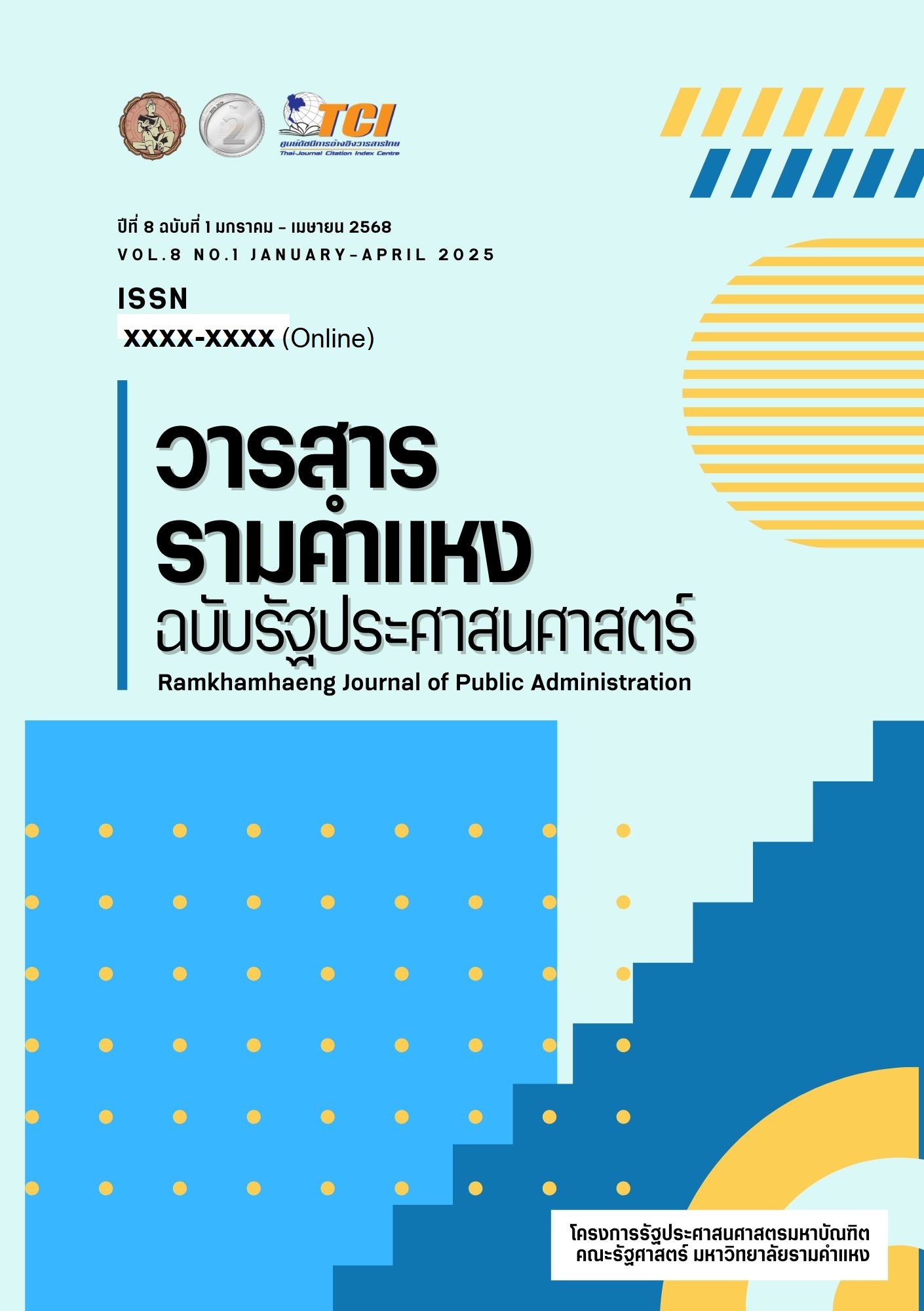ปัจจัยที่ส่งผลต่อประสิทธิภาพในการปฏิบัติงานของบุคลากรกองช่าง องค์การบริหารส่วนจังหวัดลพบุรี
คำสำคัญ:
ประสิทธิภาพในการปฏิบัติงาน, บุคลากรกองช่าง, องค์การบริหารส่วนจังหวัดบทคัดย่อ
การศึกษาวิจัยครั้งนี้มีวัตถุประสงค์เพื่อศึกษา 1) ระดับปัจจัยภายในองค์กรที่ส่งผลต่อประสิทธิภาพในการปฏิบัติงาน 2) ระดับประสิทธิภาพในการปฏิบัติงาน และ 3) ปัจจัยภายในองค์กรที่ส่งผลต่อประสิทธิภาพในการปฏิบัติงาน รูปแบบการวิจัยนี้เป็นการวิจัยเชิงปริมาณ กรอบแนวคิดที่ใช้ประกอบการวิจัย คือ แนวคิด 7S ของ Robert Waterman, Tom Peter and Julien Phillips รวมถึง ปัจจัยที่มีอิทธิพลต่อประสิทธิภาพในการปฏิบัติงานในองค์การ ของ Peterson and
Plowman พื้นที่วิจัย คือ กองช่าง องค์การบริหารส่วนจังหวัดลพบุรี กลุ่มตัวอย่าง คือ บุคลากรกองช่าง องค์การบริหารส่วนจังหวัดลพบุรี จำนวน 70 คน ซึ่งคัดเลือกโดยใช้ตารางสำเร็จรูปของเครซี่และมอร์แกน เครื่องมือที่ใช้ในการเก็บรวบรวมข้อมูล คือ แบบสอบถาม และการวิเคราะห์ข้อมูลแบ่งออกเป็น 2 ส่วน ได้แก่ การวิเคราะห์เชิงพรรณนาด้วยสถิติ เช่น ความถี่ ร้อยละ ค่าเฉลี่ย และค่าเบี่ยงเบนมาตรฐาน และการวิเคราะห์เชิงอนุมานโดยใช้การถดถอยพหุคูณ ด้วยวิธีนำตัวแปรเข้าทั้งหมด ผลการวิจัยพบว่า 1) ระดับปัจจัยที่ส่งผลต่อประสิทธิภาพในการปฏิบัติงานอยู่ในระดับมากที่สุด โดยปัจจัยด้านโครงสร้างองค์กร เป็นอันดับ 1 รองลงมาคือ ด้านระบบการปฏิบัติงาน ด้านค่านิยมร่วม และด้านกลยุทธ์ขององค์กร ตามลำดับ 2) ระดับประสิทธิภาพในการปฏิบัติงานอยู่ในระดับมากที่สุด โดยด้านคุณภาพงาน เป็นอันดับ 1 รองลงมาคือ ด้านปริมาณงาน และด้านเวลา ตามลำดับ และ 3) ปัจจัยภายในองค์กรไม่ส่งผลต่อประสิทธิภาพในการปฏิบัติงานของบุคลากรกองช่าง องค์การบริหารส่วนจังหวัดลพบุรีอย่างมีนัยสำคัญทางสถิติ
เอกสารอ้างอิง
กรมส่งเสริมการปกครองท้องถิ่น. (2567). การสัมมนาวิชาการเพื่อพัฒนาเครือข่ายการปฏิบัติงานด้านช่าง ประจำปี 2567. สืบค้นเมื่อ 26 สิงหาคม 2567. จาก https://www.dla.go.th/servlet/ActivityServlet?_mode=detail&id=3462
กฤตภพ บุญมาก. (2564). ปัจจัยที่มีผลต่อประสิทธิภาพการปฏิบัติงานของบุคลากรสถานีดับเพลิงและกู้ภัยทุ่งครุ. การค้นคว้าอิสระรัฐประศาสนศาสตรมหาบัณฑิต, มหาวิทยาลัยรามคำแหง
จิตติมา อักรธิติพงศ์. (2556). เอกสารประกอบการสอนวิชาการพัฒนาประสิทธิภาพในการทำงาน (Efficiency Development). พระนครศรีอยุธยา: มหาวิทยาลัยราชภัฏพระนครศรีอยุธยา, คณะวิทยาการจัดการ.
ทรงศักดิ์ ภูสีอ่อน. (2554). การประยุกต์ใช้ SPSS วิเคราะห์ข้อมูลงานวิจัย. มหาสารคาม: สำนักพิมพ์มหาวิทยาลัยมหาสารคาม.
ธิษิรินทร์ ปัญญายุทธศักดิ์. (2561). ปัจจัยตามหลักแนวคิด 7S ที่ส่งผลต่อประสิทธิผลการดำเนินงานของเทศบาลเมืองสัตหีบ. การค้นคว้าอิสระทวิปริญญาทางรัฐประศาสนศาสตร์และบริหารธุรกิจ, มหาวิทยาลัยรามคำแหง.
นลพรรณ บุญฤทธิ์. (2558). ปัจจัยที่ส่งผลต่อประสิทธิภาพในการปฏิบัติงานของบุคลากร องค์การบริหารส่วนจังหวัดชลบุรี. วิทยานิพนธ์บริหารธุรกิจมหาบัณฑิต, มหาวิทยาลัยบูรพา.
วาโร เพ็งสวัสดิ์. (2553). สถิติประยุกต์สำหรับการวิจัยทางสังคมศาสตร์. กรุงเทพฯ: สุวิริยสาส์น.
วิโรจน์ พุทธวิถี. (2553). การจัดการโลจิสติกส์ ชุมพลังของธุรกิจยุดใหม่. กรุงเทพฯ: วอเตอร์แปซิฟิก.
วิษณุ กิตติพงศ์วรการ. (2563). ปัจจัยที่มีผลต่อประสิทธิภาพการทำงานของพนักงานรัฐวิสาหกิจแห่งหนึ่ง. ปริญญานิพนธ์บริหารธุรกิจมหาบัณฑิต, มหาวิทยาลัยศรีนครินทรวิโรฒ.
สมใจ ลักษณะ. (2546). การพัฒนาประสิทธิภาพในการทำงาน. กรุงเทพฯ: มหาวิทยาลัยราชภัฏสวนสุนันทา, คณะวิทยาการจัดการ.
สมพิศ สุขแสน. (2556). เทคนิคการทำงานให้มีประสิทธิภาพ. สืบค้นเมื่อ สิงหาคม 26, 2567, จาก http://library.uru.ac.th/article/htmlfile/technic_work1.pdf
สิรินภา ทาระนัด. (2561). การศึกษาประสิทธิภาพในการปฏิบัติงานของข้าราชการส่วนท้องถิ่น ในเขตพื้นที่อำเภอจอมทอง จังหวัดเชียงใหม่. การค้นคว้าอิสระบริหารธุรกิจบัณฑิต, มหาวิทยาลัยราชภัฎเชียงใหม่.
องค์การบริหารส่วนจังหวัดลพบุรี. (2567). ข้อมูลจำนวนบุคลากรกองช่าง องค์การบริหารส่วนจังหวัด. กองการเจ้าหน้าที่. ลพบุรี: ผู้แต่ง.
Best, W. J. (1997). Research in Education (10th Edition). Cape Town: Pearson Education Inc.
Harrington, E. (1913). The Twelve Principles of Efficiency. New York: The Engineering magazine.
Krejcie, R.V. and Morgan, D.W. (1970). Determining sample size for research activities. Educational and Psychological Measurement, 30(3), 607-610.
Marquardt, M.J. (1996). Building the Learning Organization. New York: McGraw-Hill.
Morphet, E. L., Jesser, D. L., & Ryan, C. O. (1967). Educational organization and administration. (2nd. edition). Englewood Cliffs, NJ: Prentice-Hall.
Peters, T.J. and Waterman, R.H. Jr. (1982). In Search of Excellence: Lessons from America's Best-Run Companies. New York: Harper Collins Publishers.
Peterson, E. and Plowman, E.G. (1953). Business Organization and Management. Homewood, IL: Richard D. Irwin
Senge’s, P.M. (1990). The fifth discipline: The art and practice of the learning organization. London: Century Press.
Waterman, R., Peters, T. and Phillips, J. (1980). Structure is not organization. Business Horizons, 23(3). 14-26.
ดาวน์โหลด
เผยแพร่แล้ว
รูปแบบการอ้างอิง
ฉบับ
ประเภทบทความ
หมวดหมู่
สัญญาอนุญาต
ลิขสิทธิ์ (c) 2025 กรวรรณ รุ่งสว่าง

อนุญาตภายใต้เงื่อนไข Creative Commons Attribution-NonCommercial-NoDerivatives 4.0 International License.



